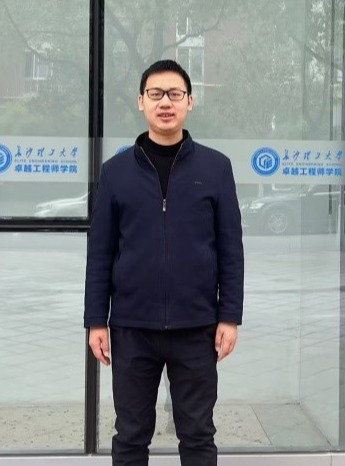 一、個人基本信息
一、個人基本信息
陳輝,男,中共黨員,工學(xué)博士,副教授,湖南省力學(xué)學(xué)會理事。主要從事材料力學(xué)性能表征與失效機(jī)理分析等方面研究。先后主持國家自然科學(xué)基金、湖南省自然科學(xué)基金、湖南省教育廳科研項目、省部級重點(diǎn)實驗室開放基金以及雙一流建設(shè)項目等,并參與國家自然科學(xué)基金重點(diǎn)項目、面上項目等國家級課題多項。在《Acta Mater》、《Appl Math Model》、《Int J Mech Sci》、《中國科學(xué)》及《力學(xué)學(xué)報》等國內(nèi)外權(quán)威期刊上發(fā)表論文40余篇,授權(quán)發(fā)明專利8項,參與制定國家標(biāo)準(zhǔn)1項。擔(dān)任《《Int J Mech Sci》、《Mater Design》、《Measurement》等期刊審稿人及國家標(biāo)準(zhǔn)評審專家。主要負(fù)責(zé)《材料力學(xué)》、《實驗力學(xué)》等課程教學(xué)工作,獲校“年度優(yōu)秀教師”,“優(yōu)秀畢業(yè)生指導(dǎo)教師”等榮譽(yù)稱號,主持湖南省普通高校教學(xué)研究與改革項目1項。
二、教育經(jīng)歷
2012.09-2019.06 西南交通大學(xué)力學(xué)與工程學(xué)院,固體力學(xué),博士
2008.09-2012.06 西南交通大學(xué)力學(xué)與工程學(xué)院,工程力學(xué),學(xué)士
三、主要研究方向
1. 無損/微損力學(xué)表征方法;
2. 先進(jìn)材料跨尺度力學(xué)行為;
3. 服役結(jié)構(gòu)或裝備完整性評價。
四、主持或參與項目情況
1. 國家自然科學(xué)基金青年項目, 激光增材制造金屬損傷機(jī)理及非均勻斷裂性能的原位壓痕研究, 2025-01 至 2027-12, 在研, 主持;
2. 國家自然科學(xué)基金重點(diǎn)項目, 面向服役安全的熱端結(jié)構(gòu)損傷容限可靠性設(shè)計理論與方法研究, 2023-01 至 2027-12, 在研, 主要參與;
3. 湖南省自然科學(xué)基面上項目, 選區(qū)激光熔化合金高溫后力學(xué)性能的高通量壓痕測試研究, 2025-01 至 2027-12, 在研, 主持;
4. 湖南省自然科學(xué)基金青年項目, 延性材料模量、強(qiáng)度與硬度的一體化壓痕測試方法, 2021-01 至 2023-12,結(jié)題, 主持;
5. 教育廳優(yōu)秀青年項目,鋼結(jié)構(gòu)焊接殘余應(yīng)力的微壓痕數(shù)值模擬與測試方法,2020/09- 2023/8,結(jié)題,主持;
6. 國家自然科學(xué)基金面上項目,延性材料與裂紋構(gòu)元的斷裂理論及毫微測試方法研究,2019/01-2022/12,結(jié)題,主要參與;
7. 國家自然科學(xué)基金面上項目,基于延性材料RVE破斷行為的結(jié)構(gòu)完整性評價基礎(chǔ)問題研究,2015/01-2018/12,結(jié)題,主要參與。
五、已發(fā)表的學(xué)術(shù)論文
[1] Chen H, Xiao J, Peng H, et al. A new method for predicting residual stress in light alloys using truncated conical indentation. International Journal of Pressure Vessels and Piping, 2025, 214: 105427.
[2] Meng Z, Chen H*, Peng H, et al. Evaluation method of uniaxial residual stress in metallic materials by spherical indentation[J]. Materials Today Communications, 2025, 42: 111370.
[3] Meng Z, Chen H*, Peng H, et al. A novel model to obtain equi-biaxial residual stress of metallic materials via instrumented spherical indentation[J]. Nondestructive Testing and Evaluation, 2024: 1-20.
[4] Chen H, Peng H, Cai L, et al. A novel combined dual-conical indentation model for determining plastic properties of metallic materials[J]. Journal of Materials Research and Technology, 2022, 20: 3241-3254.
[5] Fu Z, Chen H*, Peng H, et al. A novel model for obtaining both equi-biaxial and uniaxial residual stress of metallic materials by instrumented sharp indentation[J]. International Journal of Pressure Vessels and Piping, 2023, 203: 104942.
[6] Chen H, Fu Z, Chen D, et al. A unified sharp indentation method for obtaining stress-strain relations, strength and Vickers hardness of ductile metallic materials[J]. Materials Today Communications, 2022, 33: 104652.
[7] Chen H, Cai L X. An elastoplastic energy model for predicting the deformation behaviors of various structural components[J]. Applied Mathematical Modelling, 2019, 68:405-421.
[8] Chen H, Cai L X, Bao C. Equivalent-energy indentation method to predict the tensile properties of light alloys[J]. Materials & Design, 2019, 162:322-330.
[9] Chen H, Cai L X. Theoretical model for predicting uniaxial stress-strain relation by dual conical indentation based on equivalent energy principle[J]. Acta Materialia, 2016, 121: 181-189.
[10] Chen H, Cai L X. Unified elastoplastic model based on a strain energy equivalence principle[J]. Applied Mathematical Modelling, 2017, 52: 664-671.
[11] Peng Y., Cai L X, Chen H*, et al. A new method based on energy principle to predict uniaxial stress-strain relations of ductile materials by small punch testing[J]. International Journal of Mechanical Sciences, 2018, 138: 244-249.
[12] Peng Y, Cai L X, Chen H*, et al. A novel semi-analytical method based on equivalent energy principle to obtain J resistance curves of ductile materials[J]. International Journal of Mechanical Sciences, 2018, 148: 31-38.
[13] Chen H, Cai L X. Theoretical conversions of different hardness and tensile strength for ductile materials based on stress–strain curves[J]. Metallurgical and Materials Transactions A, 2018, 49(4): 1090-1101.
[14] Chen H, Cai L. A universal elastic-plastic model correlating load-displacement relation and constitutive parameters for typical testing components[J]. Results in Physics, 2019: 102230.
[15] Chen H, Cai L X. Unified ring-compression model for determining tensile properties of tubular materials [J]. Materials Today Communications, 2017, 13: 210-220.
[16] Chen H, Cai L X, Bao C. A novel model for determining tensile properties and hardness of steels by spherical indentations[J]. Strain, 2020: 12365.
[17] Chen H, Cai L X, Li C X. An elastic-plastic indentation model for different geometric indenters and its applications[J]. Materials Today Communications, 2020:101440.
[18] Peng Y, Cai L, Yao D, Chen H*, et al. A novel method to predict the stress-strain curves and J resistance curves of ductile materials by small samples[J]. International Journal of Pressure Vessels and Piping, 2019:172:48-55.
[19] Peng Y, Cai L X, Chen H*, et al. A theoretical model for predicting uniaxial stress-strain relations of ductile materials by small disk experiments based on equivalent energy method[J]. Transactions of the Indian Institute of Metals, 2019, 72(1): 133-141.
[20] Peng Y, Cai L X, Chen H*, et al. Application of a semi-analytical method that accounts for constraint effects in the determination of resistance curves of mode I cracked specimens[J]. Theoretical and Applied Fracture Mechanics, 2020,107: 102560.
[21] Liu Q, Cai L, Chen H*, et al. A novel test method based on small specimens for obtaining low-cycle-fatigue properties of materials[J]. Mechanics of Materials, 2019, 138: 103153.
[22] Liu X K, Cai L X, Chen H, et al. Semi-analytical model for flat indentation of metal materials and its applications [J]. Chinese Journal of Aeronautics, 2020, 33(12):3266-3277.
[23] Qi S, Cai L X, Bao C, Chen H, et al. Analytical theory for fatigue crack propagation rates of mixed-mode I–II cracks and its application[J]. International Journal of Fatigue, 2019, 119: 150-159.
[24] 陳輝,范中天,彭暉,等.預(yù)測金屬材料拉伸性能的圓臺形平面壓入方法[J].工程力學(xué),2024,41(11):207-216.
[25] 陳輝,蔡力勛,彭暉,等.冪硬化材料圓錐壓入完整塑性區(qū)的應(yīng)力分布模型[J].中國科學(xué):物理學(xué) 力學(xué) 天文學(xué),2023,53(01):95-104.
[26] 陳輝,傅作華,陳得良,等.基于維氏壓入理論模型的材料塑性參數(shù)與硬度一體化預(yù)測方法[J].機(jī)械工程學(xué)報,2023,59(08):132-141.
[27] 陳輝,蔡力勛,彭暉.預(yù)測鋁合金單軸力學(xué)性能的復(fù)合型雙錐壓入法[J].機(jī)械工程學(xué)報,2021,57(20):79-88.
[28] 李虎, 陳輝*, 彭暉, 等.TC17鈦合金表面殘余應(yīng)力的點(diǎn)陣式維氏壓痕測試[J].機(jī)械工程材料,2024,48(07):93-99.
[29] 陳輝, 蔡力勛, 包陳.雙錐度壓入的FAT迭代法獲取材料的力學(xué)性能[J].核動力工程, 2015, 36(5): 101-104.
[30] 張志杰, 蔡力勛, 陳輝*, 包陳, 劉曉坤.金屬材料的強(qiáng)度與應(yīng)力-應(yīng)變關(guān)系的球壓入測試方法[J].力學(xué)學(xué)報, 2019,51(01):159-169.
[31] 張希潤,蔡力勛,陳輝.基于能量密度等效的超彈性壓入模型與雙壓試驗方法[J].力學(xué)學(xué)報,2020,52(03):787-796.
[32] 賀屹, 蔡力勛, 陳輝*, 彭云強(qiáng). 求解I型裂紋構(gòu)元J積分的半解析方法[J].力學(xué)學(xué)報, 2018, 50(3): 579-588.
[33] 賀屹,蔡力勛,陳輝. 基于能量等效原理的K因子、柔度統(tǒng)一模型[J].機(jī)械工程學(xué)報, 2018,54(14):98-106.
[34] 尹濤, 蔡力勛, 陳輝, 姚迪. 基于毫小薄片試樣獲取材料應(yīng)變疲勞性能的測試方法[J].機(jī)械工程學(xué)報, 2018, 54(10): 68-77.
[35] 尹濤,蔡力勛,陳輝, 姚迪. TA17合金薄片材料毫小試樣疲勞性能研究.工程力學(xué), 2018,35(11):206-215.
[36] 劉勤,蔡力勛,陳輝.用于薄片試樣彈塑性應(yīng)力-應(yīng)變分析的半解析方法[J].航空學(xué)報,2018,39(11):90-101.
[37] 張志杰,鄭鵬飛,陳輝,蔡力勛.基于能量等效原理的金屬材料硬度預(yù)測方法[J].工程力學(xué),2021,38(03):17-26.
[38] 于思淼, 蔡力勛, 姚迪, 包陳, 陳輝,等. 準(zhǔn)靜態(tài)條件下金屬材料的臨界斷裂準(zhǔn)則研究.力學(xué)學(xué)報,2018, 50(5): 1063-1080.
[39] 尹濤,蔡力勛,陳輝,包陳.利用小尺寸缺口試樣測定延性材料的單軸本構(gòu)關(guān)系[J].航空材料學(xué)報,2016,36(01):81-86.
[40] 陳輝,蔡力勛,包陳.基于小圓環(huán)試樣獲取金屬材料單軸本構(gòu)關(guān)系的FAT方法[J].應(yīng)用數(shù)學(xué)和力學(xué),2014,35(S1):136-140.
[41] 陳輝,蔡力勛,姚迪,包陳.基于小尺寸材料試驗與有限元分析的耦合方法獲取材料力學(xué)性能[J].機(jī)械強(qiáng)度,2014,36(02):187-192.
六、授權(quán)專利
[1] 蔡力勛, 陳輝, 劉曉坤, 包陳, 張志杰. 基于球、錐一體壓頭的材料等效應(yīng)力-應(yīng)變關(guān)系預(yù)測方法, 中國, 201810677841.4 [P]. 2022-4-29,
[2] 陳輝 ,蔡力勛, 包陳,尹濤. 圓環(huán)徑向壓縮能量預(yù)測材料單軸本構(gòu)關(guān)系測定方法: 中國, 201510309391.X [P].2017-12-19.
[3] 蔡力勛,陳輝,包陳,劉曉坤. 圓球形壓入預(yù)測材料單軸應(yīng)力-應(yīng)變關(guān)系測定方法: 中國, 201610023696.9 [P].2018-07-31.
[4] 蔡力勛,陳輝,彭云強(qiáng). 雙錐形壓入預(yù)測材料單軸本構(gòu)關(guān)系測定方法: 中國, 201610024076.7 [P].2018-05-22.
[5] 蔡力勛,陳輝. 圓柱形平頭壓入預(yù)測材料單軸本構(gòu)關(guān)系的測定方法: 中國, 201610023839.6 [P].2018-07-31.
[6] 蔡力勛,陳輝. 一種基于圓錐形壓頭的已知材料殘余應(yīng)力測定方法, 201810706088.7 [P]. 2020-09-08.
[7] 彭云強(qiáng),蔡力勛,陳輝,包陳,圓盤試樣壓縮獲取材料單軸應(yīng)力-應(yīng)變關(guān)系的方法: 中國, 201610169980.7 [P].2018-06-19.
[8] 蔡力勛,彭云強(qiáng),陳輝,劉曉坤. 小沖桿試驗獲取材料單軸應(yīng)力-應(yīng)變關(guān)系的方法: 中國, 201610606265.5 [P].2018-10-30.
七、其他成果與獎勵
[1] 陳輝(10/15); 在役公路橋梁服役性能不中斷交通精準(zhǔn)診評與快速提升關(guān)鍵技術(shù), 中國公路學(xué)會科學(xué)技術(shù)一等獎, 2023.
[2] 蔡力勛, 包陳, 陳輝, 董莉, 李榮鋒, 劉曉坤,等. 金屬材料 壓入試驗強(qiáng)度、硬度和應(yīng)力-應(yīng)變曲線的測定[S].國家標(biāo)準(zhǔn) GB 37782—2019.
[3] 蔡力勛, 陳輝, 包陳. 10000個科學(xué)難題?制造科學(xué)卷—“典型構(gòu)元的力-變形彈塑性解析關(guān)系和測試方法”[M]. 科學(xué)出版社, 2018. pp. 1203-1205.